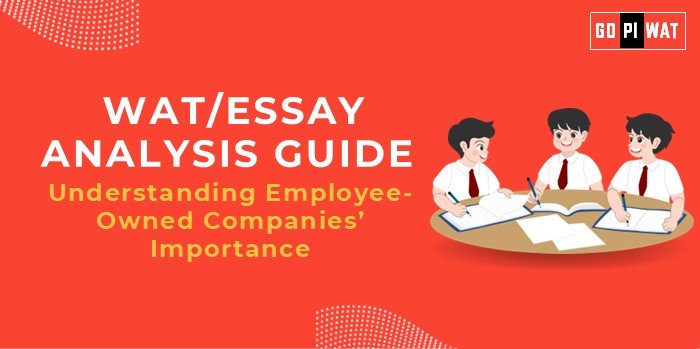📋 WAT/Essay Analysis Guide
🌐 Understanding Employee-Owned Companies’ Importance
Employee-owned companies represent a transformative model challenging the conventional shareholder-centric approach. By aligning ownership with employees, these firms drive motivation, equity, and operational resilience.
⏳ Effective Planning and Writing
- Time Allocation:
- 🕒 Planning: 5 minutes
- ✍️ Writing: 20 minutes
- 🔍 Review: 5 minutes
- Preparation Tips: Gather examples like John Lewis (UK) and Mondragon (Spain). Note productivity and retention statistics.
📄 Introduction Techniques for Essays
- Contrast Approach: “While traditional corporate models prioritize shareholder returns, employee-owned firms offer a people-centric approach, balancing profits with shared ownership.”
- Solution-Based Approach: “Employee ownership emerges as a solution to corporate inequity, improving retention, morale, and productivity.”
- Historical Approach: “Since the rise of ESOPs in the 1950s, employee-owned companies have revolutionized wealth distribution while challenging traditional corporate norms.”
📊 Structuring the Essay Body
- Paragraph 1: Achievements:
- 📈 Employee-owned companies report 4-5% productivity gains.
- 🔒 Reduced turnover rates by 50%, saving recruitment costs.
- 💰 Wealth redistribution among employees fosters financial security.
- Paragraph 2: Challenges with Comparative Analysis:
- 💸 High transition costs: Traditional corporations have capital advantages.
- ⚖️ Governance: Mondragon overcomes decision-making hurdles via cooperative leadership.
- Paragraph 3: Future Outlook: “With government incentives and increasing adoption, employee-owned firms can scale globally as sustainable models.”
🔍 Concluding Effectively
- Balanced Conclusion: “Employee-owned companies, while facing transition challenges, present a viable model for sustainable, equitable, and productive businesses.”
- Global Comparison Conclusion: “As global examples like Mondragon and John Lewis thrive, employee ownership proves its resilience and potential to outperform traditional models.”
📈 Analyzing Successes and Shortcomings
- Key Achievements: Productivity, retention, and financial equity.
- Ongoing Challenges: Transition costs, governance hurdles, capital limitations.
- Global Context: Mondragon (Spain), John Lewis (UK) as benchmarks.
✨ Recommendations for Sustainable Progress
- 💡 Government Incentives: Governments should incentivize employee ownership transitions through tax benefits.
- ⚖️ Hybrid Governance Structures: Balance employee participation with operational efficiency.
✍️ Sample Short Essays
- Balanced Perspective: “Employee-owned firms challenge the conventional corporate hierarchy by aligning ownership with performance. While transition costs remain a challenge, productivity and employee satisfaction gains highlight their potential.”
- Solution-Oriented Approach: “To address inequities and productivity challenges in traditional corporations, employee-owned models offer a sustainable solution through shared ownership and profit redistribution.”
- Global Comparison: “Global success stories like Mondragon and John Lewis demonstrate the resilience of employee-owned companies, proving they can outperform traditional models in productivity and equity.”


